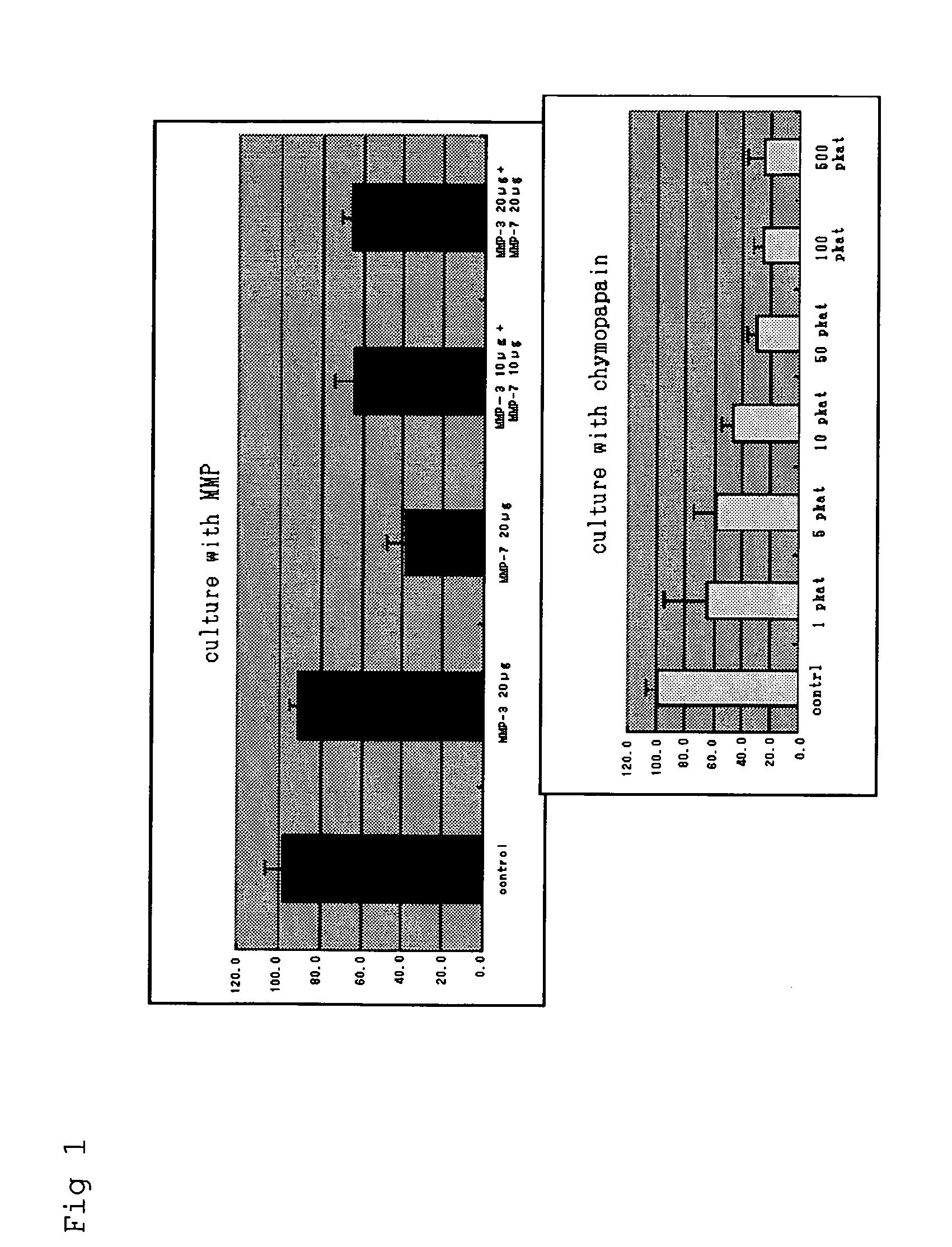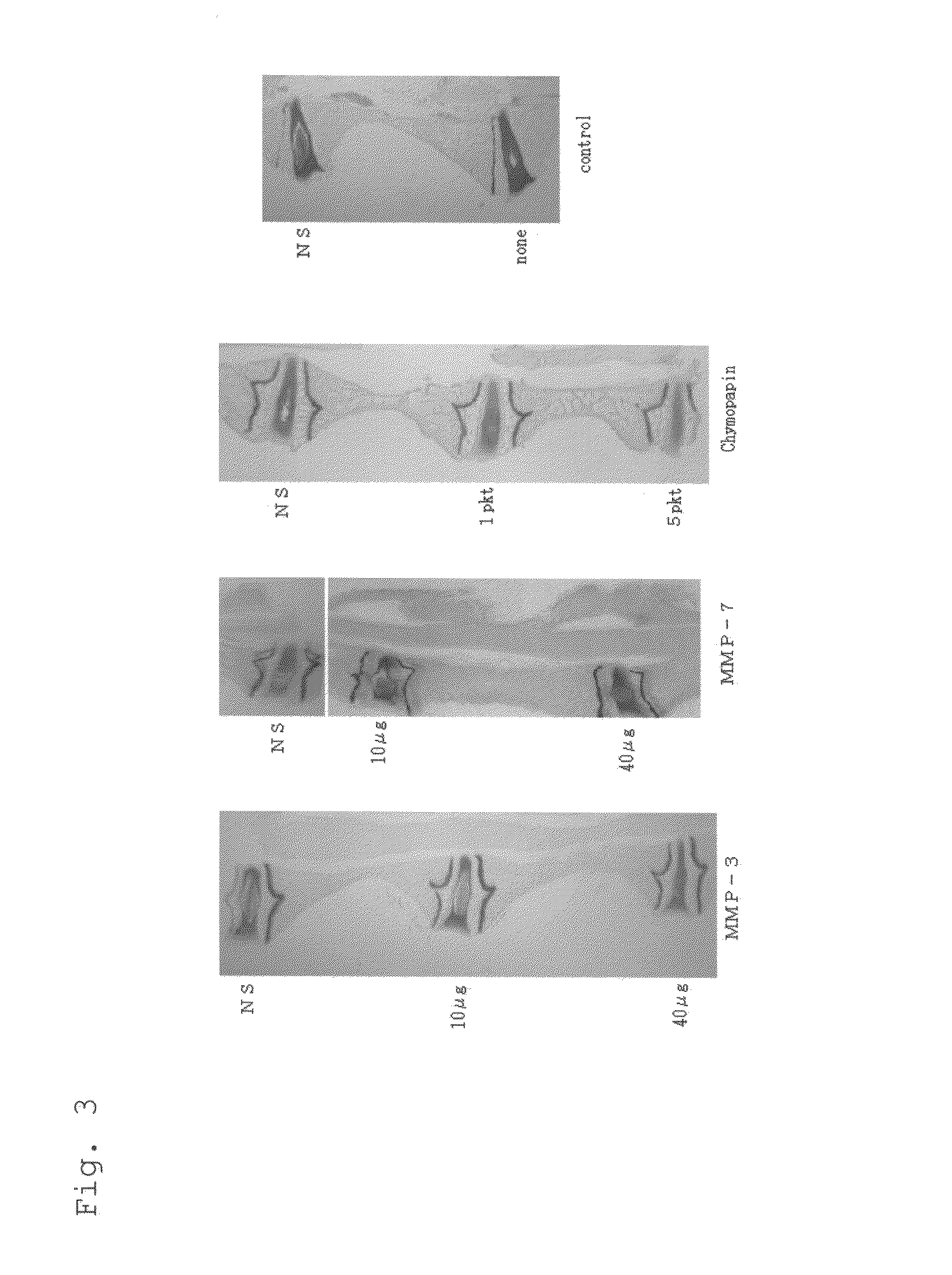Method of therapy for degenerative intervertebral discs
a technology of intervertebral discs and agents, which is applied in the direction of pharmaceutical active ingredients, drug compositions, peptide/protein ingredients, etc., can solve the problems of destruction of the double structure of the inner nucleus pulposus and the outer annulus fibrosus, and have never been attempted to use human-derived proteases, so as to maintain the regenerative capacity of intervertebral discs, promote resorption of herniated discs, d
- Summary
- Abstract
- Description
- Claims
- Application Information
AI Technical Summary
Benefits of technology
Problems solved by technology
Method used
Image
Examples
example 1
Organ Culturing Experiment Using Human Surgical Herniated Disc Specimen
[0033]A surgically extracted herniated lumbar disc specimen (stored at 4° C.) was finely sliced, and the wet weight was measured for dispensation into specimen portions of 60-80 μg, which were placed in a 96-well plate. The sample solutions described below were added and culturing was carried out for 24 hours in a CO2 incubator at 37° C.
[0034](1) Control / DMEM medium 200 μl
[0035](2) Human recombinant MMP-3 (45 kDa) 20 μg / 200 μl
[0036](3) Human recombinant MMP-7 (19 kDa) 20 μg / 200 μl
[0037](4) Human recombinant MMP-3 10 μg+human recombinant MMP-7 10 μg / 200 μl
[0038](5) Human recombinant MMP-3 20 μg+human recombinant MMP-7 20 μg / 200 μl
[0039](6) Chymopapain 1, 5, 10, 50, 100, 500 pkt (picoKatal) / 200 μl
[0040]The human recombinant MMP-3 (CHEMICON) and human recombinant MMP-7 (CHEMICON) were dissolved in DMEM medium at 4° C. The chymopapain was used as a positive control, dissolving chymopapain (ICN Biomedicals) in a solut...
example 2
Experiment for Injection into Rabbit Intervertebral Disc
[0043]Japanese white rabbits (3-4 kg) were treated by the procedure described below, and the effects of intervertebral disc injection of drug agents were examined.
[0044]1. Premedication treatment was subcutaneous injection of 0.5-1.0 ml / kg of ketamine hydrochloride.
[0045]2. The bodies were fixed, and anchored with tape on a line along the ear vein with a 23 G winged needle. Pentobarbital sodium was diluted to half-concentration (0.5 mg / ml) with normal saline and 0.5-1.0 ml / kg was injected in one shot for intravenous anesthesia. Appropriate 1 ml portions were then injected thereafter. The bodies were then shaved with a hair clipper and fixed in the lateral prostrate position (posterior approach).
[0046]3. A draping and electric scalpel (air tome) set was used to cut the skin, the subcutaneous area was opened up, and the muscle was separated from the vertebral body and costa to expose the intervertebral discs.
[0047]4. The followin...
example 3
Experiment for Injection into Canine Herniated Disc
[0059]Dogs, and particularly beagles, have a high incidence of herniated disc, exhibiting paralysis of both of the lower limbs in severe cases. The histology of canine herniated disc is highly similar to the histology of human herniated disc. A sample was prepared from tissue surgically extracted from the 1st / 2nd lumbar herniated disc of a 7-year-old, 6.35-kg miniature dachshund that had suffered herniated disc and lower limb paralysis, and was hematoxylin-eosin stained and imaged on a micrograph, shown in FIG. 4. This tissue sample demonstrates that canine herniated disc is highly suitable as a model for human herniated disc.
[0060]Drug agents were injected into the herniated discs of beagles with spontaneous herniated disc, and the effects were examined in the following manner. A 7-year-old, 12.75-kg beagle was used for a human recombinant MMP-7 test, and a 7-year-old, 14.4-kg beagle was used for a human recombinant MMP-3 test. The...
PUM
| Property | Measurement | Unit |
|---|---|---|
| wet weight | aaaaa | aaaaa |
| pH | aaaaa | aaaaa |
| concentration | aaaaa | aaaaa |
Abstract
Description
Claims
Application Information
 Login to View More
Login to View More - R&D
- Intellectual Property
- Life Sciences
- Materials
- Tech Scout
- Unparalleled Data Quality
- Higher Quality Content
- 60% Fewer Hallucinations
Browse by: Latest US Patents, China's latest patents, Technical Efficacy Thesaurus, Application Domain, Technology Topic, Popular Technical Reports.
© 2025 PatSnap. All rights reserved.Legal|Privacy policy|Modern Slavery Act Transparency Statement|Sitemap|About US| Contact US: help@patsnap.com



